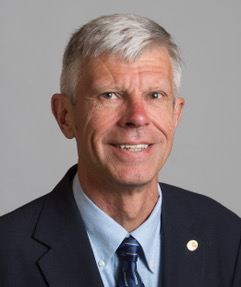Drake University professor’s study cited in 2023 Nobel Prize in Physics
Tuesday, October 24th, 2023
Professor Klaus Bartschat’s 2014 paper identified a source of error in experimental results obtained with Nobel Prize-winning technology

Ellis and Nelle Levitt Distinguished
Professor of Physics
This year’s Nobel Prize in Physics was awarded to three Laureates for the development of extremely short laser pulses, which—for the first time—can be used to image electron dynamics in atoms and molecules. This breakthrough enables the study of fundamental physics questions, such as the time it takes for an electron to escape from an atom or molecule exposed to electromagnetic radiation, also known as the Photoelectric Effect. It is also expected to have important consequences in medicine and materials development.
The Nobel Prize announcement cited findings from a 2014 paper titled, Time delays for attosecond streaking in photoionization of neon, authored by Dr. Klaus Bartschat, the Ellis & Nelle Levitt Distinguished Professor of Physics at Drake University, alongside co-authors Johannes Feist, Oleg Zatsarinny, Stefan Nagele, Renate Pazourek, Joachim Burgdörfer, Xiaoxu Guan, and Barry I. Schneider.
“Our group is very excited to have pin-pointed the source of the problem in an experiment performed in the group of a Nobel Prize winner,” Professor Bartschat said.
Background
In 1921, Albert Einstein won the Nobel Prize in Physics for explaining the Photoelectric Effect. While this was important for science on many levels, Einstein did not indicate how long it might take for an electron to escape from the target. Whatever that time may be, however, it was believed to be so immeasurably short that the process was essentially viewed as instantaneous until assertions of a non-zero time delay between absorption of the light and the electron escape were made in 2010.
In a pioneering experiment published in 2010, experimentalists in Munich, Germany in the group of the Ferenc Krausz (one of the 2023 Nobel Prize winners) claimed to have measured a time difference of 21 attoseconds for electrons escaping from two different subshells of the Neon atom.
“One attosecond is 1 billionth of 1 billionth of a second,” explained Professor Bartschat. “For illustration purposes, there are about twice as many attoseconds in one second as there are seconds in the age of the universe.”
Several theoretical groups all over the world tried to reproduce the experimental results but failed. They did find a difference, but it was approximately 10 attoseconds, or about half the time of what the experimentalists claimed. In 2014, Dr. Bartschat of Drake University, and his co-authors, published their paper, in which they also obtained about 10 attoseconds. However, instead of just publishing their number, they went further and suggested a so-called “shake-up” mechanism, i.e., a temporary occupation of other subshells in neon, as a potential source of error in the interpretation of the experimental results.
In 2017, the experiment was repeated in Lund, Sweden by the group of Anne L’Hullier (another of the Nobel Prize winners). They were able to eliminate the shake-up mechanism by improving the energy resolution and, indeed, confirmed the theoretical prediction of this being the problem in the earlier setup.
Applications in Science and Society
In addition to addressing fundamental questions in quantum physics, being able to produce and control such short pulses is expected to have important consequences for a large number of applications, including diagnostics and treatment in medicine, as well as the potential of affecting chemical reactions to make new materials with specially designed properties.
“In other words, we will not only be able to image and measure electron dynamics, but hopefully one day also manage to influence the electrons in ways previously thought to be impossible,” said Professor Bartschat.

